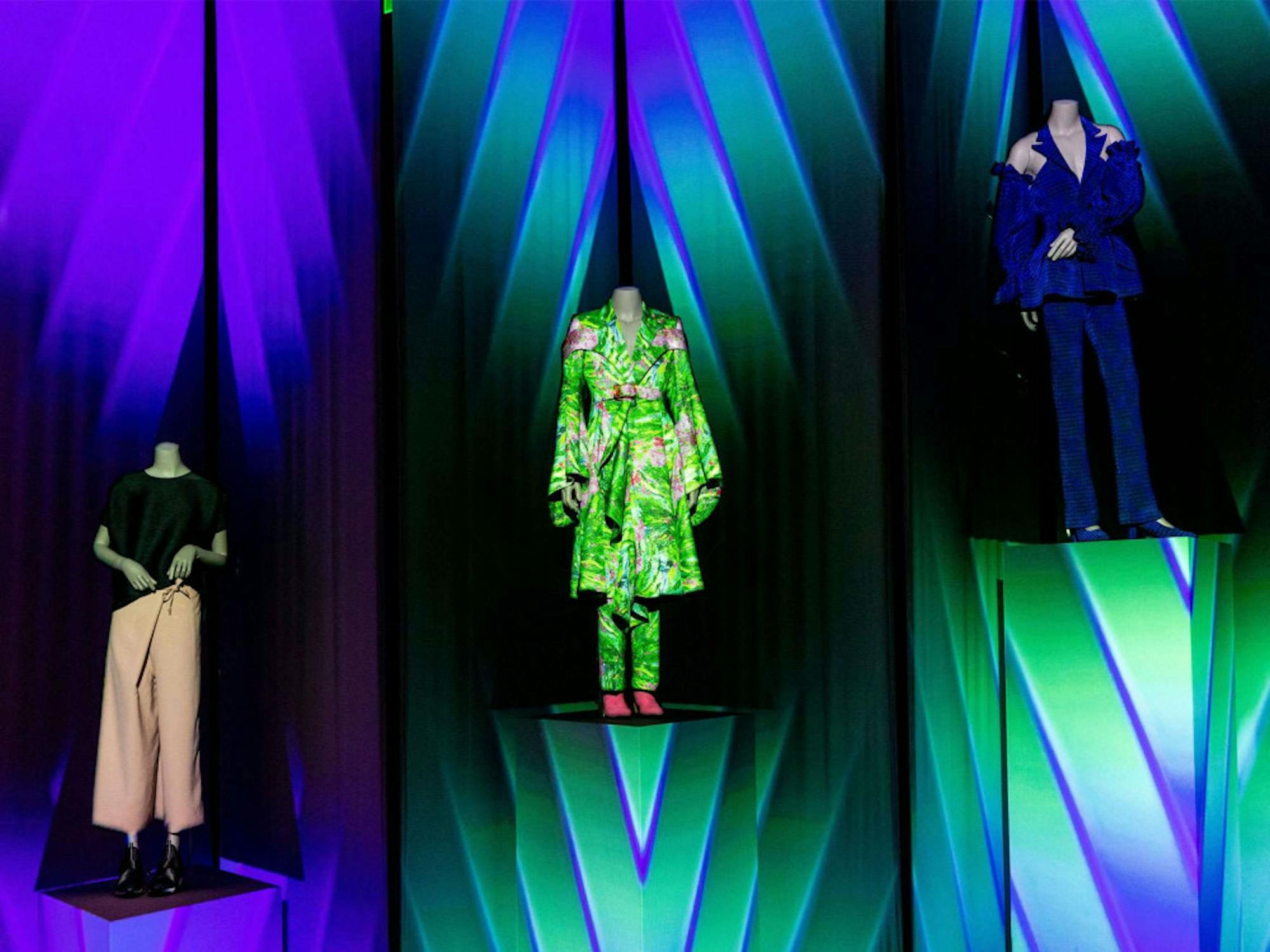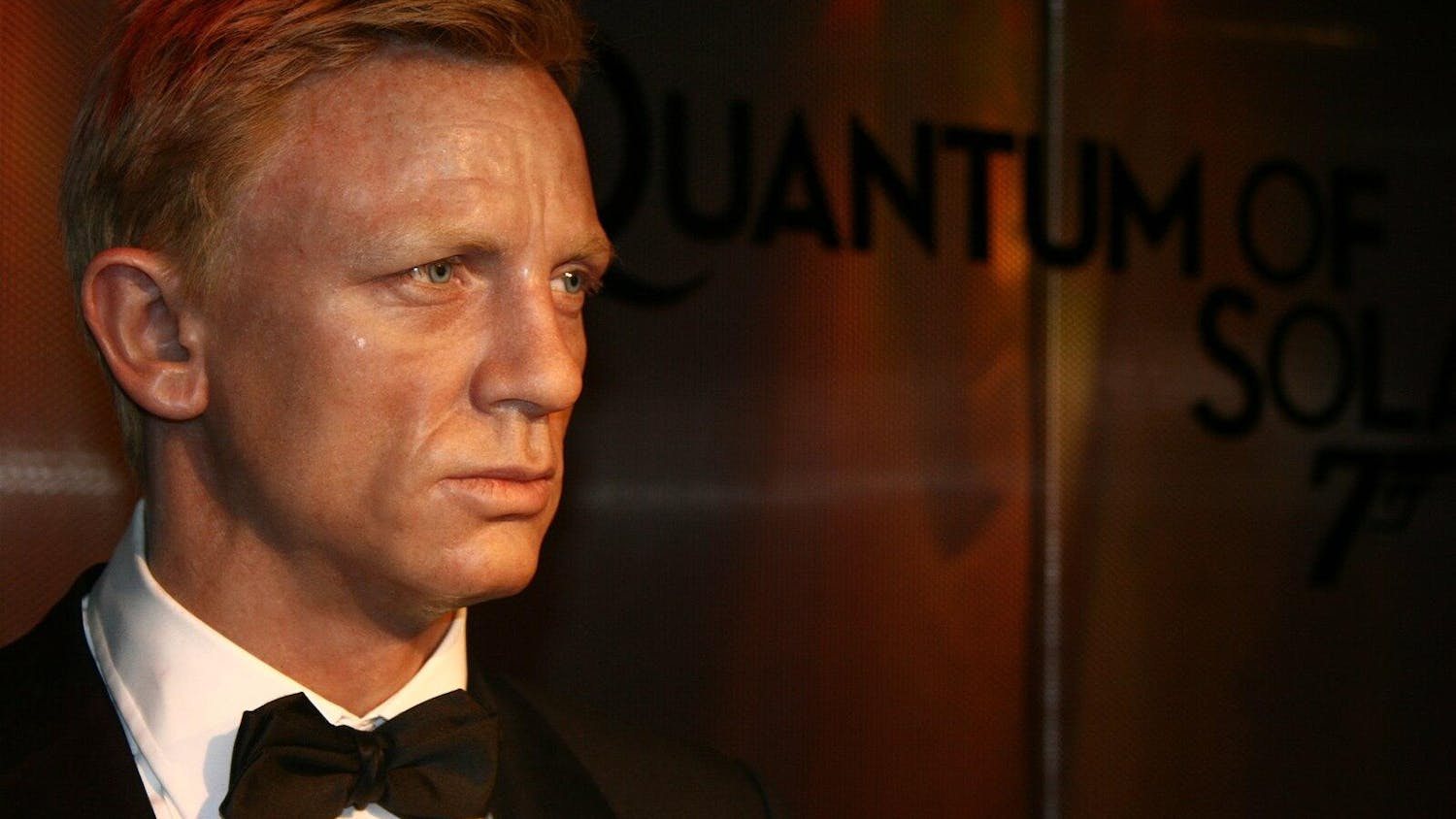The Museum of Fine Arts, Boston (MFA)’s current exhibition, “Gender Bending Fashion,” showcases various forms of fashion and specific designers that have challenged the rigid division of male and female dress. Clothing has long served as a way to communicate nonverbally about one’s identity, and how someone dresses plays a key role in how they are perceived publicly. The exhibit examines how society has put in place institutions, specifically fashion, that aim to describe gender as a strict binary. “Gender Bending Fashion” celebrates how fashion, an art form that elicits passionate , emotional responses, has had a role in disrupting the societal norms of gendered clothing. The exhibit showcases some of the specific works that have played a part in pushing back against the binary definitions of clothing, from haute couture to ready-to-wear and street fashion.
The design of the exhibit itself feels reminiscent of a runway show. The walls are almost entirely black, except for pops of holographic writing and fluorescent colors behind the works. Upbeat vocal music that goes along with the overall runway feeling plays as soon as you walk through the doors. The exhibit highlights three ways in which fashion has played a role in challenging the strict gender binary present in the world of fashion: disrupt, blur and transcend. By highlighting these three specific functions of fashion, the exhibit makes clear the power of each piece, since the spacing of the exhibit roughly grouped pieces into these categories.
The first section in the exhibit is titled “Disrupt.” This portion of the exhibit highlights moments when designers and other fashion-forward people fought against the norms of a man wearing a suit and a woman wearing a skirt. The exhibit specifically notes how indecency laws in many cities in the United States in the 19th and 20th centuries targeted people who were “wearing a dress not belonging to his or her sex,” citing a law adopted by San Francisco. Such laws show how ingrained the gender binary in clothing was;, therefore, they highlight how important it was for designers and wearers to advocate for change.
The exhibit shows how designers first began to design suits for women and how they continue to do so today. Suits are a symbol of patriarchal power, and they were mostly reserved for men until around the 19th century. Around this time, and especially into the 20th century, the availability of ready-to-wear suits for women began to rise. Designers such as Anne Klein, Ralph Lauren, Donna Karan, Giorgio Armani and Calvin Klein were among those who began to refashion the suit for women. This shift toward women wearing suits highlights the desire of women to gain equal power to men, since the suit is such an iconic symbol of male power. The exhibit then presents how designers and wearers have continued to challenge gender norms in fashion today. The exhibit notes designers and labels such as Yohji Yamamoto, Vivienne Westwood, Comme des Garçons, Christian Siriano and Bindle & Keep that have designed contemporary ‘menswear’ for women. A particularly exciting piece within this section of the exhibit is the evening suit by Christian Siriano, styled by Alexandra Mandelkorn and worn by Janelle Monáe to the Vanity Fair Oscars party in 2018. This piece is bright red with a beautiful bow tie neckpiece, and it looks as stunning in person as it did in pictures.
The other part of the “Disrupt” section highlights when designers and wearers showed men in skirts; the “Peacock Revolution,” a time in the 1960s and 1970s when men pushed back against gender stereotypes in fashion; and wearing suits with brighter color palettes and more vibrant patterns. While it has become increasingly common for women to wear suits, it seems much less typical for men to wear skirts. Designers like Rei Kawakubo, Walter Van Beirendonck and Alejandro Gómez Palomo have all experimented with adapting skirts to the male silhouette. The work by Alejandro Gómez Palomo, “Objeto Sexual,” was particularly striking with its vibrant floral patterns and unconventional shape.
The next section of the exhibit is “Blur,” where the rigid distinctions between men’s and women’s fashion were obscured. This shift occurred in areas including children’s clothing and sportswear. As it became more acceptable for women to engage in activities like swimming, bicycling and motoring, there was an increase in the silhouettes available for women. With this shift in activewear, there was a rise in “unisex” fashion where designers made clothes that both women and men could wear. Works by designers like Rudi Gernreich and Rick Owens were featured in this section of the exhibit. This section also featured an all-denim work by Levi Strauss & Co. worn by Marlene Dietrich.
The final section of the exhibit is “Transcend.” This section of the exhibit emphasized the importance fashion has played in society as a whole — and specifically in how it has affected the way fashion is gendered. The “Transcend” section features work by four designers that all represent a new type of fashion, which is attempting to change how gender is represented and moves toward designing clothing for anyone instead of a specific gender. The labels highlighted in this section are Two Point Two Studio, Not Equal, Rad Hourani and Palomo Spain. A particularly striking piece in the last room was the “Boy Walks into an Exotic Forest” ensemble by Palomo Spain. This work was bright green floral print with dashes of pink. Its jacket-and-pants silhouette was beautiful, loose and cinched at the waist with a matching belt. The works by Two Point Two Studio were also interesting due to their edgy, loose silhouettes.
“Gender Bending Fashion” will be on display until Aug. 25 and is free for Tufts students.
MFA's 'Gender Bending Fashion' presents history of gender re-imagined through clothes

The 'Gender Bending Fashion' installment is depicting, featuring from left to right: Not Equal, Ensemble, 'ZerO' collection, Fall 2013. Polyester. Museum purchase with funds donated by the Fashion Council; Palomo Spain, Boy Walks into an Exotic Forest ensemble, Spring/Summer 2017. Museum purchase with funds donated by the Fashion Council; Palomo Spain, Suit, Objete Sexual, Fall 2017. Cotton.





